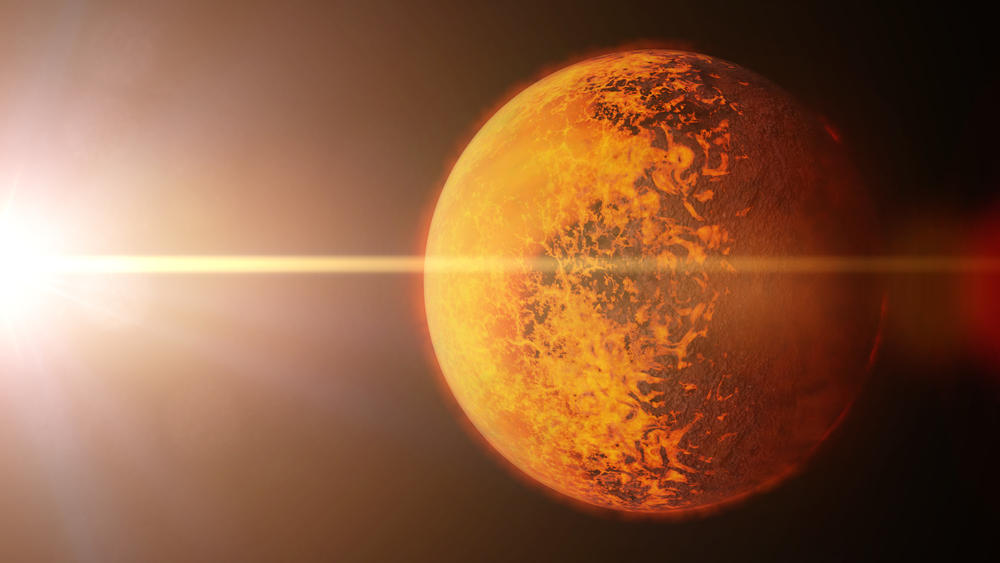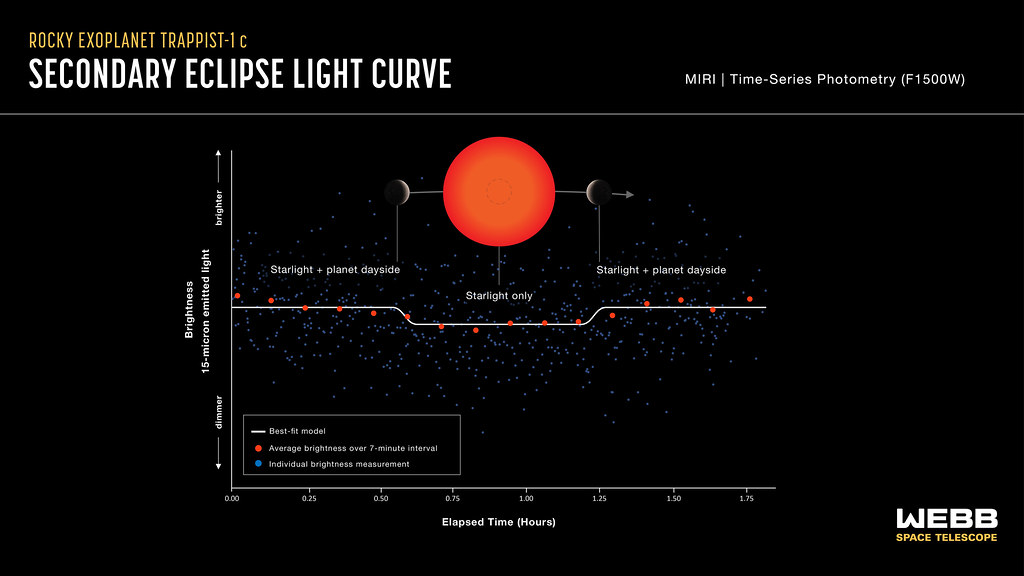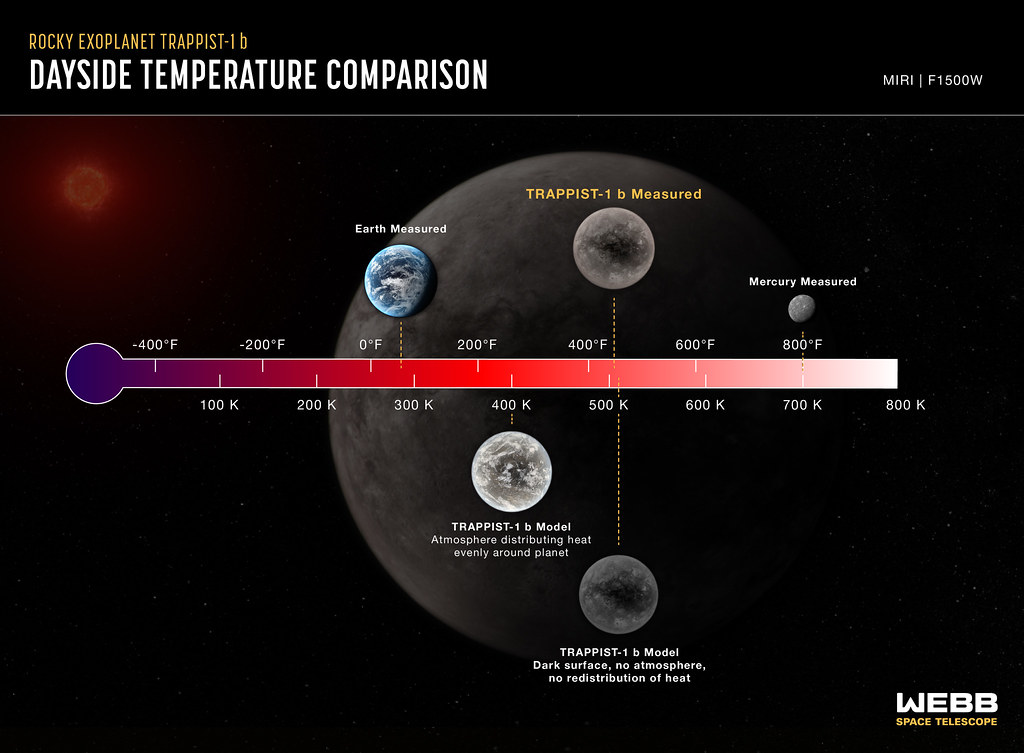Table of Contents (click to expand)
The JWST is already renowned for accessing information that could not be obtained before. Now it has managed to determine the temperature of an exoplanet. Astronomers widely consider the James Webb Space Telescope (JWST) as the pinnacle of space telescopes. The largest and the most powerful telescope ever launched into space, it is the successor to the Hubble Space Telescope.
Many believe that with the JWST, we will be able to observe more distant regions of the universe than ever before. It comprises several cameras and spectrometers that can detect infrared radiation. Some of these instruments include the Near Infrared Spectrograph (NIRSPEC), the Mid-Infrared Instrument (MIRI) and the Near Infrared Camera (NIRCam).
Scientists expect to obtain information that will help us determine what the early universe looked like, along with the formation and evolution of galaxies, and the birth of stars inside nebulous gas and dust.
However, another essential mission of the JWST is to investigate the atmospheres of exoplanets and determine if the observed planets have the ingredients needed to host life.
On March 27 2023, the JWST managed to measure the daytime temperature of a rocky exoplanet, TRAPPIST-1 b. In this article, we will see just how the JWST achieved this.

Theoretically Measuring A Planet’s Temperature
In theory, we can measure the temperature of celestial bodies using a law called the Stefan-Boltzmann Law. This law relates the temperature of a body with its flux (a measure of how much light it emits).
So, to theoretically calculate the temperature of a planet, we need to find the flux of its parent star (which can be measured), the distance between that planet and its star, and the planet’s ‘albedo’. The albedo is a quantity that accounts for the fraction of starlight reflected off a planet.
A planet with an albedo of 1 (one) would perfectly reflect all light incident on it, whereas one with 0 (zero) albedo would absorb all radiation incident on it.

Astronomers then determine the planet’s temperature using the planet’s albedo value and the total flux from its host star.
This method of calculating the planet’s temperature is a simple and rather crude approach, as it does not account for the internal physical processes and mechanisms in the planet’s atmosphere, like its heat redistribution. It also does not consider the fact that the planet’s near and far side in relation to the star will have different temperatures.
However, we can develop models that factor in the effect of the atmosphere redistributing heat around the planet. These models can also account for the impact of tidal locking, when one side of the planet faces the star forever, and even the color of the planet’s surface (the darker it is, the more radiation from space will be absorbed).
Also Read: How Do Scientists Determine The Composition And Atmosphere Of Other Planets?
Measuring A Planet’s Temperature Using MIRI
The JWST consists of several cameras and spectrometers onboard. Using the Mid-Infrared Instrument (MIRI), consisting of both a camera and a spectrograph, the dayside temperature of the planet TRAPPIST-1 b was measured.

The MIRI performed the photometric observations of TRAPPIST-1 b just as it started its secondary eclipse. A secondary eclipse refers to when an exoplanet starts going behind its host star, as viewed by an observer like the JWST. The JWST took the observations using the F1500W filter of the MIRI. This filter allows for detecting infrared radiation of particular wavelengths, like those that scientists expect to see from exoplanets.
As TRAPPIST-1 b is a planet, it does not emit any light of its own. However, it does glow when observed in the infrared range. The MIRI is, therefore, an ideal observation tool for exoplanets. By detecting it in infrared, we can find its flux or brightness.
The MIRI, using the F1500W filter, observed TRAPPIST-1 b during five different instances of secondary observations. The observational data consists of the planet’s brightness measurement in infrared radiation. Then, the scientists reduce and optimize it using computer software and obtain a ‘light curve’ of the exoplanet.

The light curve shows how the infrared flux decreases when the secondary eclipse starts. Before this eclipse begins, the JWST records the brightness of the star TRAPPIST-1 and its exoplanet TRAPPIST-1 b. However, as the planet starts moving behind its star, it is obscured from the telescope’s view. It shows up as a slight decrease in the brightness observed by the JWST. This reduction in brightness comes as a small dip in the light curve.
To obtain the planet’s temperature, astronomers first measure this decrease in brightness, also called the eclipse depth, using the exoplanet’s light curve. They find the planet’s flux during the daytime using this depth value. Astronomers then used Planck’s radiation law to determine the temperature.
Using this method, the dayside temperature of the exoplanet, TRAPPIST-1 b, was estimated at around 503 K.
Also Read: Why Does The James Webb Space Telescope (JWST) View Space In Infrared Light?
Temperature And Atmosphere Of TRAPPIST-1 B

Meanwhile, computer models show that if it did not have an atmosphere with proper heat distribution, TRAPPIST-1 b would have a temperature slightly above 500 K. However, if TRAPPIST-1 b did have an atmosphere that distributes heat evenly, its day temperature would come close to 400 K.
The comparison of those models seems to imply that TRAPPIST-1 b is more likely a rocky planet with no atmosphere. If it did have an atmosphere, the heat would spread over it evenly, lowering its temperature during the day.
This feat of the JWST is just the start. Its ability to find a secondary eclipse is itself a massive achievement. By measuring the temperature of a planet, we can uncover whether it has an atmosphere, which is an essential step to determine if a planet could harbor life.
Also Read: What Is The Temperature In Outer Space?
With more such observations of other planets, we will learn more about the chances of life evolving on other planets. Finding out more about the origins of life is also one of the missions of JWST. Scientists hope that this new generation of observation will be able to provide more information about the properties of the atmospheres present in other exoplanets out there in the cosmos.
How well do you understand the article above!

References (click to expand)
- Solar System Astronomy, Lecture Number 8.
- James Webb Space Telescope | University of Arizona.
- Mid-Infrared Instrument (MIRI) - James Webb Space Telescope.
- James Webb Space Telescope Science.
- NASA's Webb Measures the Temperature of a Rocky ....
- TP Greene. (2023) [2303.14849] Thermal emission from the Earth-sized ....
